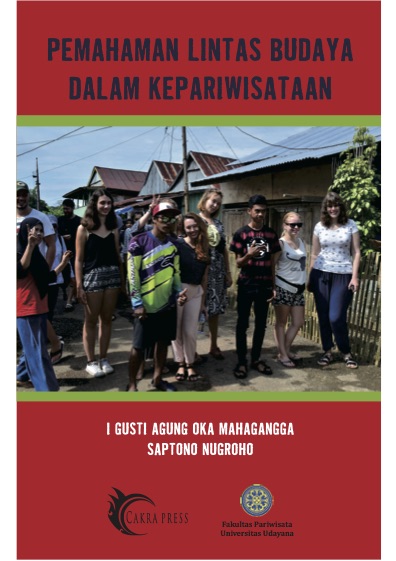
Cross Cultural Understanding in Tourism
I Gusti Agung Oka Mahagangga, Saptono Nugroho
ISBN : 9786029320780 Published : 2017
Abstrak
Chapter 1 explains the definition of communication, the definition of cross-culture and its relation to tourism as part of the socio-humanities. Students understand the scope of cross-cultural understanding of learning in tourism, Students understand the purpose and function of studying cross-culture in tourism and Students realize the importance of cross-cultural understanding and cultural sensitivity.
Chapter 2 specifically explains communication from the perspective of communication science with the aim of providing communication learning limitations in cross-cultural understanding. Students are expected to understand the scope of communication science learning in cross-cultural understanding in tourism and students understand the use of communication concepts and theories in explaining cross-cultural phenomena.
Chapter 3 explains the definition of culture and the application of cultural anthropology in explaining cultural phenomena in the context of cross-cultural understanding. Students are expected to understand the use of cultural concepts and theories in explaining cross-cultural phenomena in the relationship between host and guest and between communicator and communicant.
Chapter 4 seeks to elaborate communication and culture in cross-cultural understanding. It is expected that students will be able to explain communication patterns and cultural patterns in tourism.
Chapter 5 explains verbal and nonverbal messages in cross-cultural understanding. Students are able to explain the form of verbal and non-verbal messages in cross-cultural understanding and students understand the context of verbal and non verbal communication.
Chapter 6 discusses communication breakdowns, recognizing cultural information and the ability to identify cross-cultural communication climates. Students are expected to gain an understanding of the risks of communication disorders, an understanding of cultural information and gain an understanding of how to communicate with an understanding of the communication climate.
Chapter 7 contains quite dense substance, consisting of analysis, cases, and cross-cultural understanding strategies in tourism. Students are introduced to the method of cross-cultural analysis and find out cross-cultural cases that occur in tourism. The biggest hope is for students to be able to apply cross-cultural analysis methods and provide examples of cross-cultural cases in tourism. Students are able to apply conceptual-theoretical dissect cross-cultural cases in tourism by trying to implement cross-cultural strategies in tourism.
